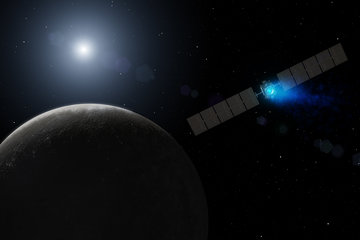A three-dimensional view of the Milky Way
The Apex telescope makes it possible to observe molecular clouds and star births in the galactic plane
In our Milky Way, there are about 200 billion suns as well as large quantities of gas, some of which serves as raw material for star births. The gas collects in compact lumps but also appears as extended molecular clouds. Astronomers have used the Apex sub-millimetre telescope in Chile to look deep into the galactic plane and measure the interstellar medium. They studied the distribution of the cold molecular gas in the inner region of the Milky Way with unprecedented accuracy. The researchers catalogued more than 10,000 interstellar clouds. They found out that currently only about 10% of them contain stars. The project is called SEDIGISM (Structure, Excitation and Dynamics of the Inner Galactic Interstellar Medium) and covers an area of 84 square degrees in the southern sky.

The mapping contains data from 2013 to 2017, which was collected by the 12-metre Apex telescope in the Chilean Andes. “With the publication of this most detailed map of cold molecular clouds in the Milky Way to date, a long-term observation project is now coming to fruition”, says Frederic Schuller from the Max Planck Institute for Radio Astronomy, the project leader of SEDIGISM.
Scientists have been able to observe the southern part of the inner Milky Way with an angular resolution of 30 arcseconds; this corresponds to ¹⁄₆₀ of the apparent diameter of the full moon in the Earth’s sky. They have also gained valuable information on structure, distance, and velocity for all galactic molecular clouds in about two thirds of the inner disc of the Milky Way.
The researchers observed the spectral lines of the carbon monoxide molecule – including the rare isotopes 13CO and C18O – and deduced the mass and three-dimensional distribution of cold and dense molecular gas in the interstellar medium. Various structures such as filaments and recesses were found; these are the result of different physical effects.
Molecular clouds contain the raw material from which new stars are formed. The mapping of these clouds is therefore necessary to determine important parameters such as the efficiency of star formation in the Milky Way. Structures and physical conditions within the clouds provide the fundamental basis for the theories of star formation. It is therefore important to spatially resolve the individual clouds and distinguish them from each other.
One key to the success was the 12-metre Apex telescope with its highly accurate surface and one of the world’s best locations for sub-millimetre astronomy. The instrument is located at an altitude of 5100 meters on the Chajnantor Plain in the Chilean Atacama Desert. Here, there is extremely low water vapour content and thus excellent transparency of the atmosphere.
The new data complement a series of mappings of the galactic plane produced in the mid to far infra-red wavelength range over the past decade. This was done with space telescopes such as the Spitzer, Herschel, and – for longer wavelengths – the Apex itself. However, these projects lacked the speed information that SEDIGISM has now provided. The re-analysis of the data allows a more detailed study of star formation – and thus of the structure and dynamics of the Milky Way itself.
HOR / NJ












